External and Internal Spillovers - Governor Philip R. Lane
12 May 2017
Speech

56th ACI FMA World Congress
Introduction
It is an honour to speak at the ACI World Congress and welcome delegates to Dublin.1
Today, I wish to discuss two types of macro-financial interactions that are relevant in understanding the macro-financial dynamics of the euro area. First, there are inward and outward linkages between the euro area and the rest of the world that may generate external spillovers by which shocks and policies elsewhere affect macro-financial conditions in the euro area and, in turn, shocks and policies in the euro area matter for macro-financial conditions in the rest of the world. Second, there are even stronger linkages across the member countries within the euro area, such that internal spillovers matter for each member state in the euro area.
Both external and internal spillovers are relevant in evaluating the impact of the ECB’s monetary policy. In particular, the ECB has pursued a multi-dimensional monetary policy since mid-2014 that has combined a negative deposit rate, an asset purchase programme, targeted long-term refinancing operations (TLTROs) and forward guidance on the expected future path for its policies. This strategy was adopted in recognition of the risk of persistent under-shooting of its inflation target, including a tail risk of deflation.
As captured in the introductory statement to the most recent monetary policy press conference on 27th April 2017, the Governing Council of the ECB expects the key ECB interest rates to remain at present or lower levels for an extended period of time and well past the horizon of its net asset purchases. Net asset purchases are expected to run at a monthly pace of €60 billion until the end of December 2017 or beyond, if necessary, and in any case until the Governing Council sees a sustained adjustment in the path of inflation consistent with its inflation aim.2
The assessment of the Governing Council is that this very substantial degree of monetary accommodation is still needed for underlying inflation pressures to build up and support headline inflation in the medium term. If the outlook becomes less favourable, or if financial conditions become inconsistent with further progress towards a sustained adjustment in the path of inflation, the Governing Council stands ready to increase the asset purchase programme in terms of size and/or duration.
In analysing the stance of monetary policy, it is essential to incorporate the impact of external conditions on the design of the ECB’s monetary measures, while also recognising the role of the external sector in determining their effectiveness. From a global perspective, the external spillovers from the ECB’s monetary strategy also matter for macro-financial conditions elsewhere and may affect optimal monetary strategies for other central banks.
In addition, from the perspective of individual member countries, the national impact of the ECB’s monetary strategy depends on a host of country-specific factors, together with the indirect impact through the matrix of inter-linkages among the member countries. To the extent that there is a mis-match between the current macro-financial conditions in an individual member country and the ECB’s monetary stance, this can be analytically viewed as a type of internal spillover generated by the deviation vis-a-vis macro-financial conditions in the rest of the euro area. We will return to the analysis of internal spillovers later in the speech.
External Spillovers
In thinking about external spillovers, it is important to bear in mind that nature and magnitude of spillovers varies over time, across regions and across different states of the world. Accordingly, it is essential to adopt an empirical approach in assessing the role of spillovers at a given point in time.
To this end, let me make a few empirical observations.
First, as shown in Figure 1, the share of world GDP (measured in current US dollars) that is generated by emerging and developing countries has risen sharply from about 20 percent in 2000 to 30 percent in 2007 and 40 percent in 2017. In relation to the trade channel, Figure 2 shows that this group is collectively far more important than the United States as a trading partner for the euro area. It follows that the assessment of macro-financial conditions in these economies is an important task in determining the appropriate monetary stance for the euro area.
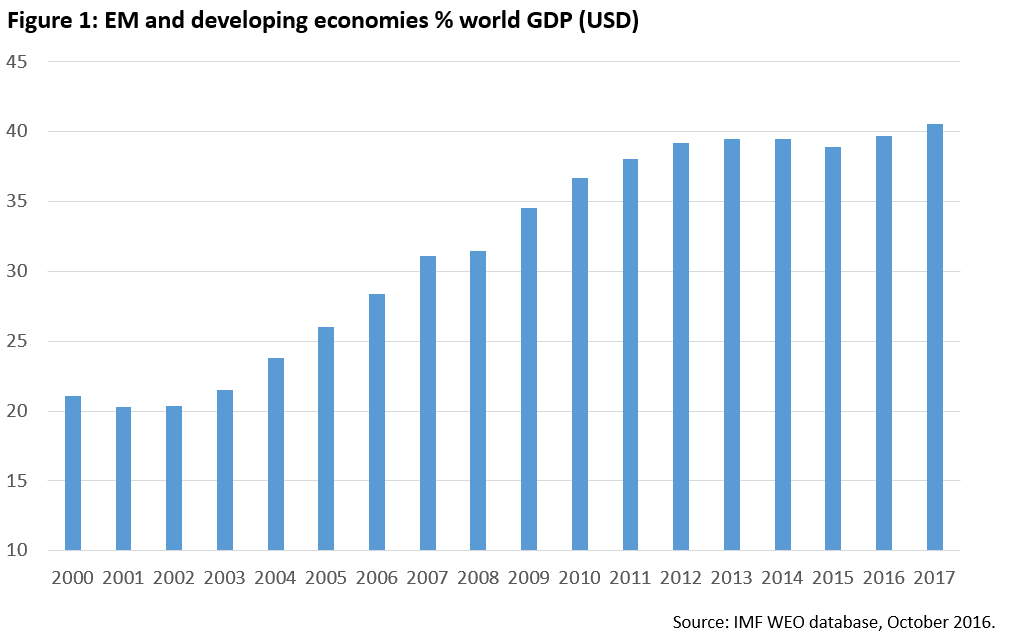
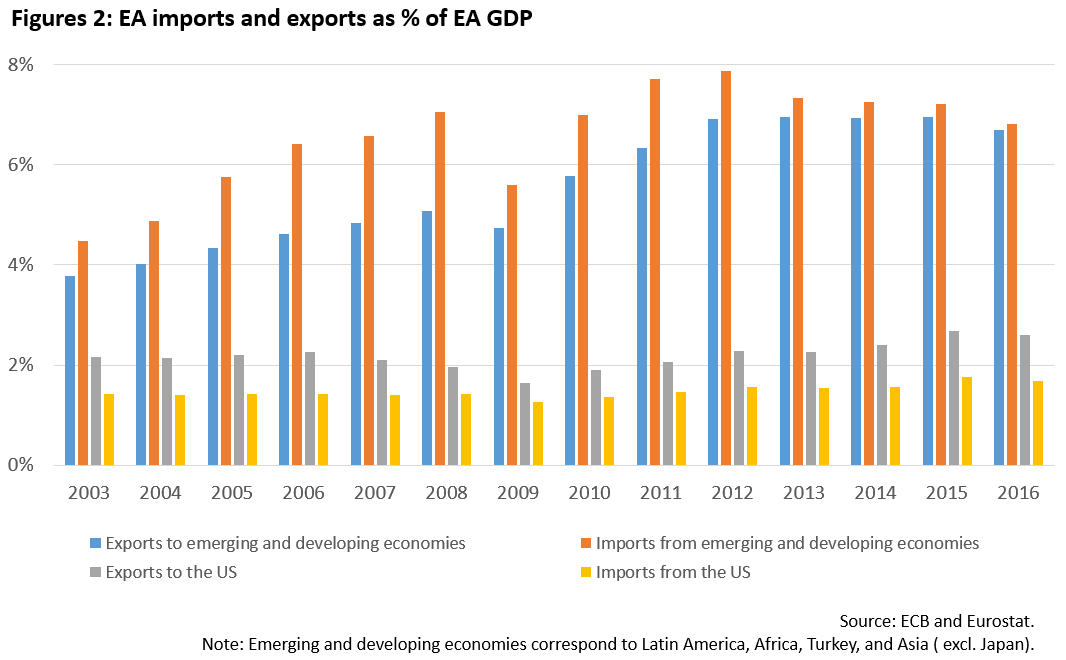
Second, the nature of external linkages and spillovers inevitably varies with the current state of the euro area economy. To take just one dimension, some transmission mechanisms are a function of output levels, while others are a function of domestic expenditure levels. Accordingly, the cross-border transmission of shocks and policies will differ depending on the direction and magnitude of the euro area’s trade balance, which is simply the difference between output and expenditure.
Figure 3 shows net exports as a share of GDP for the euro area: the current net surplus position means that the domestic expenditure level in the euro area is running substantially below the output level. A related point is captured in Figure 4 that shows the time-varying accounting contribution of net exports to GDP in the euro area. While net exports were quite significant during 2010-2013 and again during 2015 (the first full year of the ECB’s accommodative monetary strategy), the accounting contribution of net exports was marginally negative during 2016.
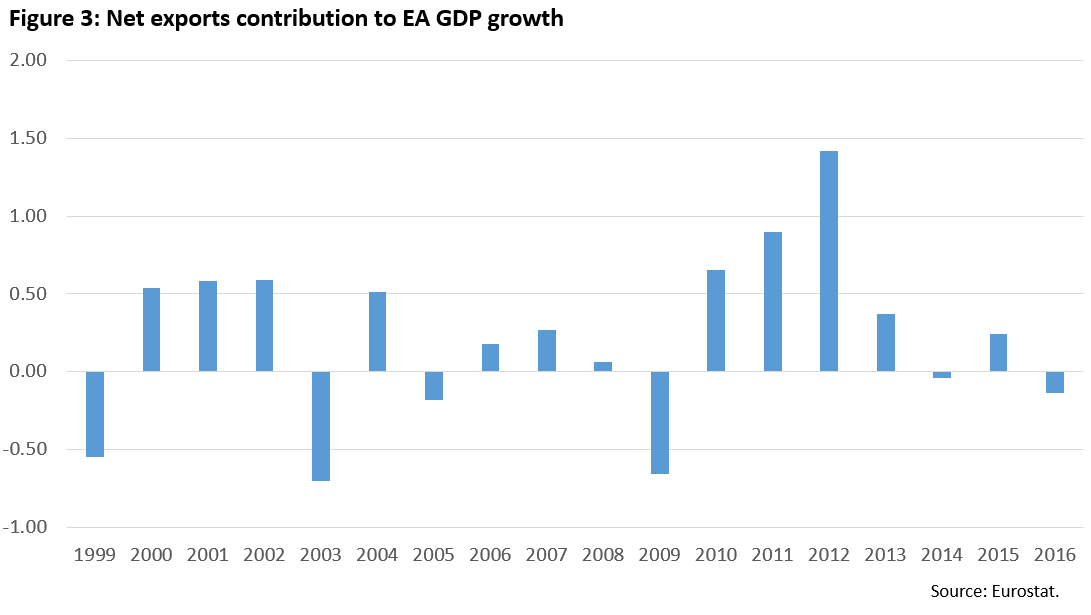
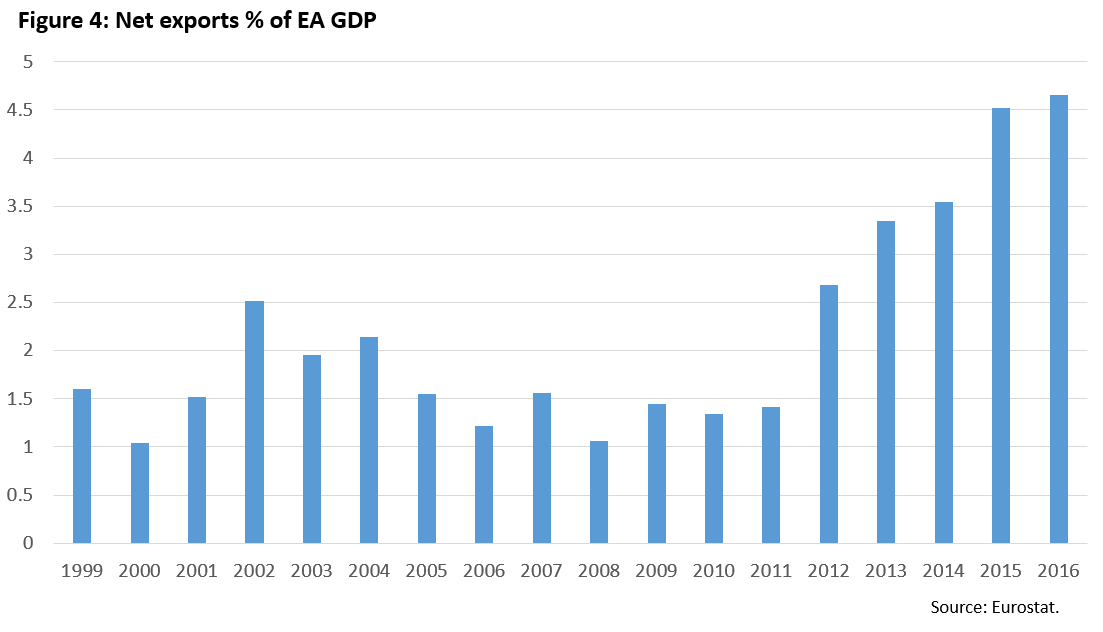
Third, the extent and composition of international financial linkages matter for external spillovers that operate through financial channels. Drawing on my joint research with Gian Maria Milesi-Ferretti of the International Monetary Fund, Figure 5 shows the expansion in the size of international balance sheets (relative to world GDP) since 1990. Furthermore, it illustrates the increase in prominence of financial centres as intermediaries of international financial assets and liabilities and the rising prominence of emerging and developing countries as holders and issuers of international financial positions.
In relation to the former, the intermediation of financial flows through international financial centres calls for a deeper level of analysis in order to understand the underlying sources and destinations for international financial flows, which is hampered by the considerable data gaps in the tracking of international financial transactions. In relation to the latter, increasing interdependence means that close monitoring of financial conditions in emerging economies is essential in evaluating risks to domestic financial conditions in advanced economies.
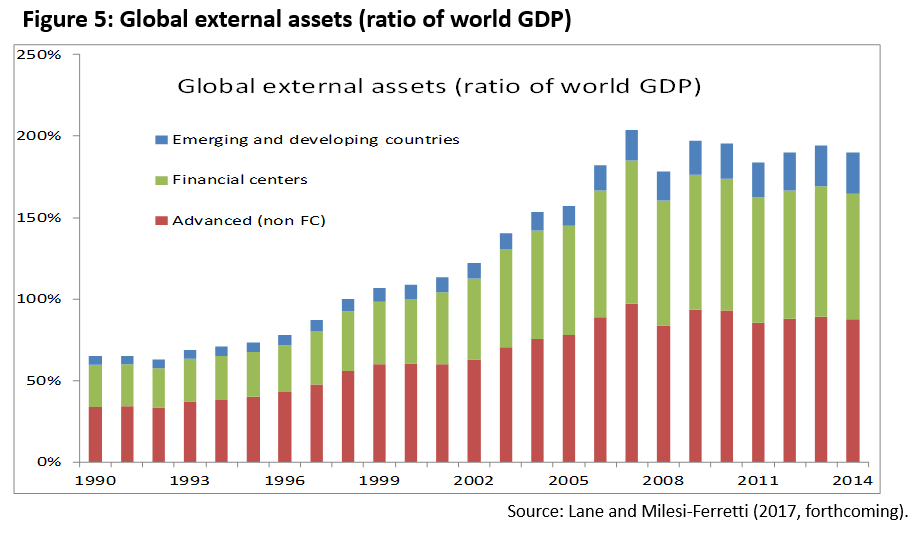
Fourth, the external value of the euro has varied sharply across time. This matters for the transmission of shocks and policies both through output and financial channels. As an illustration, Figure 6 shows the euro-dollar rate over 1999-2017. Even if 1999-2001 depreciation and 2002-2007 appreciation of the euro against the dollar had limited direct impact on the conduct of monetary policy during the 1999-2007 period, these medium-term fluctuations plausibly exerted considerable influence on financial conditions in the euro area, given the extensive bilateral linkages between the US and European financial systems and the unique role of the dollar in the international financial system.3
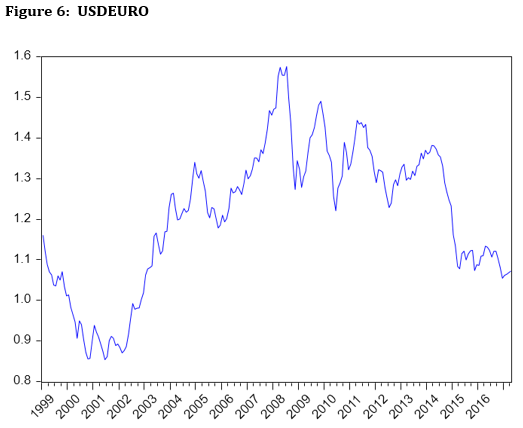
More recently, it is plausible that diverging monetary strategies between the ECB and the Federal Reserve played a role in the appreciation of the euro against the dollar from mid-2012 to mid-2014 and the subsequent depreciation in the second half of 2014 and early 2015. However, in evaluating the transmission mechanisms of the ECB’s accommodative monetary policy, it is important to bear in mind the relative stability of the dollar-euro rate since Spring 2015.4
Taking into account these empirical patterns, how should we think about the interactions between external spillovers and the ECB’s monetary policy?
In the inward direction, the euro area is affected by macro-financial conditions in the rest of the world through trade, exchange rate and financial channels.
The relative prices of tradable goods (especially commodities and other non-differentiated goods) are determined by global supply and demand conditions. Most obviously, the analysis of the global factors driving the persistent and large-scale fluctuations in oil prices has been a priority for all central banks in recent years. In addition, global excess capacity may have constrained pricing for various manufacturing sectors in recent years.
In addition to their influence on the terms of trade, external demand conditions also may boost domestic output levels, especially in situations in which domestic expenditure levels are weak. For the euro area, an expansion in net exports clearly played an important role in sustaining output during 2010-2013 and again in 2015.
Furthermore, it is plausible that the depreciation in the external value of the euro between mid-2011 and mid-2012 and again between mid-2014 and mid-2015 contributed to the expansion in net exports, while the appreciation phases from mid-2010 to mid-2011 and mid-2012 to mid-2014 represented headwinds to recovery in the euro area.5
With the exception of currency reversal during the euro crisis phase of mid-2011 to mid-2012, the euro persistently appreciated against the dollar from mid-2010 to mid-2014. During this period, the Federal Reserve implemented several phases of quantitative easing. In turn, the sharp depreciation of the euro against the dollar from mid-2014 to mid-2015 correlates with the adoption by the ECB of an accommodative monetary strategy, including asset purchase programmes, a negative deposit rate, forward guidance and targeted long-term refinancing operations. At this broad level, it seems clear that differences in the phasing and scope of monetary strategies account for some proportion of the medium-term swings in the exchange rate over this period.
While Figure 2 showed that bilateral trade vis-à-vis the US is relatively limited, the importance of the euro-dollar rate for exporters and importers in the euro area is amplified by the dollar tracking strategies of many emerging economies, together with the dominant role of the dollar in international price setting.6
At the same time, the rising share of emerging and developing economies in world GDP (as captured in Figure 1) means that it is also necessary to allow for the possibility of discrete shifts in the currency values of major emerging economies (vis-à-vis the euro) that would materially affect the external environment facing the euro area. For emerging economies, sizeable currency movements over a short interval may occur through a combination of the greater inherent volatility of emerging economies and the potential sensitivity of the exchange rate to revisions in reserve management strategies.7 As it has turned out, this risk has not been realised in recent years, even if concerns have been elevated at various times (including in early 2016).
It is important not to exaggerate the exchange rate as a transmission mechanism for monetary policy.8 In particular, in relation to the ECB’s current monetary strategy, the dollar-euro rate and, more generally, the effective exchange rate for the euro area have been relatively stable since April 2015 (at least compared to the amplitude of the fluctuations during 2008-2014) and the net export channel in fact turned negative in 2016.
That is, the ECB’s monetary policy has substantially operated through domestic channels over the last two years, with the improvement in financial conditions facilitating a recovery in domestic expenditure, led by consumption. It follows that the recovery in the euro area economy in combination with a stable exchange rate constitutes a positive external spillover for the rest of the world.
So far, I have focused on external macroeconomic spillovers. In addition, external spillovers may operate through financial channels. As was illustrated in Figure 5, the scale of cross-border financial integration has sharply increased over the last two decades, with financial systems intertwined through two-way cross holdings. Financial conditions in the euro area are affected by external financial shocks via international balance sheet effects, shifts in international financial flows and common influences on discount factors and risk premia.9
The history of the last fifteen years illustrates the importance of global factors in determining financial conditions. During 2003-2007, easy credit conditions and a risk-on attitude pervaded the financial systems of advanced economies, which was reinforced by the international reallocation of liquidity across regions. In turn, this period was followed by the sudden stop of the global financial crisis during 2008-2009.
Since 2010, there has been more diversity in financial conditions across the globe due to differences in speed of recovery from the crisis, the state of balance sheets and variation in policy decisions. Under these conditions, there is greater potential for adverse external policy spillovers since countries are at different points in the tightening-loosening policy spectrum.
In addition, lower bound constraints mean that it is more problematic for a central bank to offset an externally-driven tightening in financial conditions through domestic monetary easing.10 Furthermore, a tightening in financial conditions is especially damaging during phases in which domestic sectoral balance sheets are under repair. Given these constraints, a well-designed monetary strategy can provide a strong anchor for domestic financial conditions by providing clear forward guidance on the commitment of the central bank to meeting its medium-term inflation target.
Internal Spillovers
Its unique status as a monetary union of nineteen member countries means that it is essential to address also internal spillovers within the euro area. The high levels of trade and financial integration among the member countries mean that the scope for cross-border internal spillovers is especially acute. Indeed, avoiding the disruptive impact of shifts in national currency values (including from a political economy perspective) was one of the motivating factors behind the formation of the monetary union.11
Let me focus on a particular type of internal spillover: if macro-financial conditions in an individual member country substantially deviate from the rest of the euro area, the area-wide monetary policy may not be optimal from the perspective of the country in question.12 In this sense, the macro-financial conditions in the rest of the euro area spillover to this country through their impact on monetary policy.
To mitigate the impact of this type of internal spillover, it is now widely accepted that national macroprudential policies can play an important role, especially in relation to differences in financial cycles across member countries.13 In addition, taking due account of fiscal sustainability considerations, counter-cyclical national fiscal policies can contribute to macro-financial stabilisation. In fact, recent analysis shows that there are complementarities between national macroprudential policy and counter-cyclical fiscal policies, which limits the burden placed on either policy instrument if both are simultaneously deployed.14 Through such mechanisms, the impact of internal spillovers within the monetary union and any potential financial stability side effects of the area-wide common monetary policy can be mitigated.
Conclusions
In summary, the focus of this speech on external and internal spillovers serves to illustrate the analytical challenges in determining the optimal monetary strategy for the ECB and the appropriate set of domestic ancillary policies for the member countries of the euro area. Information exchange and the sharing of analysis across the global central banking community through fora such as the bimonthly meetings of governors at the Bank for International Settlements and the biannual meetings of the International Monetary Fund provide a valuable common platform in assessing and evaluating external spillovers.15 Equally, in relation to internal spillovers, the work of the Financial Stability Committee of the ECB and European Systemic Risk Board provides a framework to develop a shared analysis of financial stability risk within the euro area and, more broadly, across the EU.
---------------------------------------------
References
Aguiar, Mark and Gita Gopinath (2007), “Emerging Market Business Cycles: The Cycle is the Trend,” Journal of Political Economy 115, 69-102.
Ammer, John, Michiel De Pooter, Christopher Erceg, and Steven Kamin (2016). "International Spillovers of Monetary Policy," International Finance Discussion Note 2016-02-08, Board of Governors of the Federal Reserve System.
Bruno, Valentina and Hyun Song Shin (2015), “Cross-Border Banking and Global Liquidity,” Review of Economic Studies 82(2), 535-564.
Caballero, Ricardo J., Emmanuel Farhi and Pierre-Olivier Gourinchas Pierre-Olivier Gourinchas (2015), “Global Imbalances and Currency Wars at the ZLB,” NBER Working Paper No. 21670.
Carney, Mark (2016), “Redeeming an Unforgiving World,” Speech at 8th Annual Institute for International Finance G20 Conference, Shanghai, 26th February 2016.
Carvalho, Daniel and Michel Fidora (2015), “Capital Inflows and Euro Area Long-Term Interest Rates,” Journal of International Money and Finance 54(C), 186-204.
Casas, Camila, Federico J. Díez, Gita Gopinath and Pierre-Olivier Gourinchas (2016), “Dominant Currency Pricing,” NBER Working Paper No. 22943.
Dieppe, Alistair, Georgios Georgiadis, Martino Ricci, Ine Van Robays and Bjorn van Roye (2017), “ECB-Global: Introducing ECB’s Global Macroeconomic Model for Spillover Analysis,” ECB Working Paper No. 2045.
Draghi, Mario (2016), “The International Dimension of Monetary Policy,” Speech at the ECB Forum on Central Banking, Sintra, 28th June 2017.
Eichengreen, Barry (1993), “European Monetary Unification,” Journal of Economic Literature 31(3), 1321-1357.
Lane, Philip R. (2016), “The Funding of the Irish Domestic Banking System During the Boom,” Journal of the Statistical and Social Inquiry Society of Ireland XLIV, 40-68.
Lane, Philip R. and Gian Maria Milesi-Ferretti (2017), “International Financial Integration in the Aftermath of the Global Financial Crisis,” IMF Working Paper No. 17/115.
Martin, Philippe and Thomas Philippon (2017), “Inspecting the Mechanism: Leverage and the Great Recession in the Eurozone,” American Economic Review, forthcoming.
--------------------------------------------------
1 I presented earlier versions of these remarks at the CFS-IMFS “ECB and Its Watchers XVIII” Conference on the 6th of April and the IBRN-IMF “The Transmission of Macroprudential and Monetary Policies Across Borders” Conference on the 19th of April. I thank Mary Everett, Donata Faccia, Garo Garabedian and Rebecca Stuart for their inputs to this speech.
2 In addition, the strategy includes reinvestments of the principal payments from the maturing securities purchased under the asset purchase programme.
3 See, amongst many others, Bruno and Shin (2015) and Lane (2016).
4 A wider measure of the nominal effective exchange rate for the euro area is highly correlated with the dollar-euro rate.
5 I emphasise the impact of the exchange rate on activity levels, since the direct impact on the consumer price level is very limited for a continental-sized economy. The direct effect of the exchange rate on the price level is much more significant for small open economies.
6 Casas et al (2016).
7 For instance, see Aguiar and Gopinath (2007) on the volatility of emerging economies.
8 See, amongst others, Ammer et al (2016), Carney (2016) and Dieppe et al (2017).
9 For instance, see Carvalho and Fidora (2015).
10 Caballero et al. (2015).
11 See Eichengreen (1993) on the political economy problems associated with material shifts in intra-EU bilateral exchange rates.
12 The category of internal spillovers also includes intra-area contagion effects of financial crises in individual member countries. The analysis of crises is beyond the scope of this speech.
13 Macroprudential policies also have a role to play in addressing the common component in the euro area financial cycle, in view of the costs associated with deploying monetary policy to manage financial stability risks.
14 Martin and Philippon (2017).
15 See Draghi (2016).